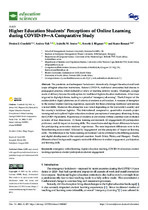| dc.contributor.author | Cranfield, Desireé J. | |
| dc.contributor.author | Tick, Andrea | |
| dc.contributor.author | Venter, Isabella M. | |
| dc.date.accessioned | 2021-09-22T13:33:09Z | |
| dc.date.available | 2021-09-22T13:33:09Z | |
| dc.date.issued | 2021 | |
| dc.identifier.citation | Cranfield, D.J.; Tick, A.; Venter, I.M.; Blignaut, R.J.; Renaud, K. Higher Education Students’ Perceptions of Online Learning during COVID-19—A Comparative Study. Educ. Sci. 2021, 11, 403. https://doi.org/10.3390/ educsci11080403 | en_US |
| dc.identifier.uri | doi.org/10.3390/educsci11080403 | |
| dc.identifier.uri | http://hdl.handle.net/10566/6774 | |
| dc.description.abstract | The pandemic and subsequent ‘lockdowns’ dramatically changed the educational landscape of higher education institutions. Before-COVID-19, traditional universities had choices in pedagogical practice, which included a variety of teaching delivery modes. Overnight, a single mode of delivery became the only option for traditional higher education institutions. All services migrated to digital platforms, leading to a period of “emergency eLearning”. The full impact of this sudden shift to digital platforms on all cohorts of students is still unclear. A measure of disruption to the normal student learning experience, especially for those attending traditional universities, was inevitable. Moreover, this disruption was varied depending on the University’s country and the country’s lockdown logistics. This international, comparative, quantitative research project investigated and explored higher education students’ perceptions of emergency eLearning during the COVID-19 pandemic. Experiences of students at universities in three countries were evaluated in terms of four dimensions: (1) home learning environment, (2) engagement, (3) participation preference, and (4) impact on learning skills. The research revealed significant differences between the participating universities students’ experiences. The most important differences were in the ‘home learning environment’, followed by ‘engagement’ and the perception of ‘impact on learning skills’. The differences in the ‘home learning environment’ can be attributed to the differing economic and digital development of the surveyed countries: South Africa, Wales, and Hungary. Finally,
different cultural backgrounds suggest a noticeable difference in student engagement, participation, and learning skills | en_US |
| dc.language.iso | en | en_US |
| dc.publisher | MDPI Educ. Sci. | en_US |
| dc.subject | emergency online learning | en_US |
| dc.subject | higher education teaching | en_US |
| dc.subject | COVID-19 | en_US |
| dc.subject | education | en_US |
| dc.subject | student learning experience | en_US |
| dc.subject | student participation | en_US |
| dc.subject | student engagement | en_US |
| dc.title | Higher education students’ perceptions of online learning during COVID-19 a comparative study | en_US |
| dc.type | Article | en_US |

